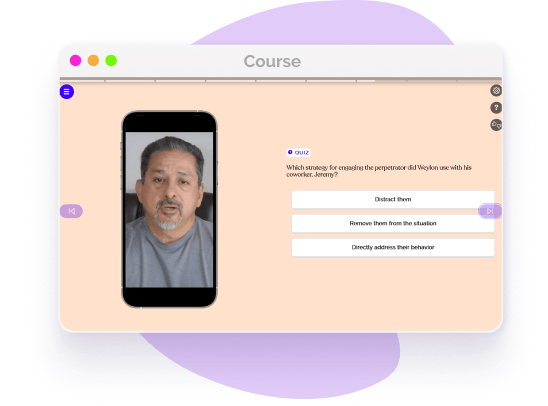Engaging the Perpetrator
If you decide to engage the perpetrator of microaggressions, discrimination, or harassment, there are a few strategies that you can use. Some techniques for engaging the perpetrator include distracting them, removing them from the situation, and directly addressing their behavior.

Confronting the perpetrator is often extremely effective
Directly engaging the perpetrators of microaggressions, discrimination, and harassment is often the most effective method for bystander intervention because it clearly communicates what behaviors are inappropriate for the setting, whether you're at work or elsewhere. Make it clear that they should stop what they’re saying or doing. If you don’t feel comfortable or safe being so direct, you can try to engage the harasser in another way, either by distracting them or by trying to remove them from the situation entirely.

Engaging the perpetrator is unique to each situation
How you engage them should be informed by the nature of the situation at hand, as well as your relationship with the perpetrator. Similar to engaging the target, you might strike up an unrelated conversation with the perpetrator or ask them to accompany you to another location. If you are acquainted with them, it may be easier to confront them directly than if they are a stranger. In that case, distracting them might be a better tactic. Remember, you have a lot of options to choose from as a bystander.

In the context of workplace harassment, engaging with a perpetrator can have several potential benefits, including:
By engaging with a perpetrator and helping them understand the impact of their behavior, you may be able to encourage them to change their behavior in the future. This can help to create a safer and more respectful workplace for everyone.
Engaging with a perpetrator can help to raise awareness of the harmful impact of their behavior and the importance of respectful and professional conduct in the workplace. By making them aware of how their behavior is perceived and how it affects others, they may be more likely to recognize the harm they have caused and take steps to change their behavior.
By making it clear that their behavior is not acceptable and will not be tolerated, you send a message that harassment will be taken seriously and that there are consequences for engaging in this type of behavior.

Engaging the Perpetrator can be successful, but sometimes risky
Bystander intervention that directly confronts those who are committing microaggressions, discrimination, and harassment is frequently the most successful. But it can also be riskier than other strategies, even if you're just intervening in microaggressions, and especially if you're intervening in a potentially violent setting. Always keep your safety in mind. Directly engaging a perpetrator can be challenging, but you can practice and develop the skills it takes to do so successfully.
Ways to Engage the Perpetrator
Immediately confronting a perpetrator of harassment, discrimination, or microaggressions can be difficult, however, you can train and develop the skills required to do so effectively.
Here are some myths to look out for:
- -
Distract the perpetrator
- -
Remove them from the situation
- -
Directly address their behavior

Empowering employees to safely engage a perpetrator
This chapter outlines the ways that employees can engage the perpetrator of microaggressions, bias, harassment, or violence in the workplace. It covers topics such as directly confronting the individual, removing them from the location, or distracting them with a conversation. Providing employees with the skills and best practices for standing up to a perpetrator can help make your work environment safer for everyone.

Helping over 8,000 organizations create a safer, more productive workplace
EasyLlama’s online training course helps prepare employees to navigate bystander intervention. The course guide learners how to appropriately confront harassment, discrimination, and microaggressions in the workplace. The course covers:





















